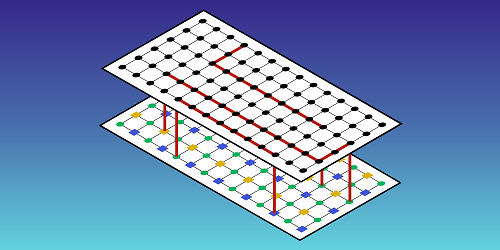Streamlined Quantum Error Correction
In quantum computing, the inherent fragility of quantum bits, or qubits, inevitably leads to calculational errors. The so-called surface code is a widely used technique for correcting such errors, but it requires many additional qubits and is thus poorly suited for large-scale quantum computation. Now Noah Berthusen at the National Institute of Standards and Technology, Colorado, and the University of Maryland, College Park, and his colleagues have demonstrated a promising alternative error-correction protocol [1]. The approach uses fewer extra qubits compared with the surface code yet offers a competitively high performance.
The researchers’ method applies error-correction codes called quantum low-density parity-check codes. “Parity check” refers to a relatively simple way to verify that the computer’s qubits are in their expected states, and “low density” refers to the fact that each verification involves only a few error-correction qubits. The new protocol increases the efficiency of these codes on quantum computers that require interactions only between neighboring qubits. In part, this improvement is achieved by arranging both the computer’s qubits and the error-correction qubits in a specific bilayer structure. It is also achieved by performing parity checks more frequently on nearby qubits than on widely separated ones.
Through classical simulations of error-prone quantum computations, Berthusen and his colleagues show that the accuracy of their error-correction technique can match or even exceed that of the surface code. They say that their findings could provide a path toward large-scale fault-tolerant quantum computation. But they also note that future work will need to solve some outstanding problems, such as the complexity of the error-correction operations and cases in which the error-correction qubits lose their quantum information when not in use.
–Ryan Wilkinson
Ryan Wilkinson is a Corresponding Editor for Physics Magazine based in Durham, UK.
References
- N. Berthusen et al., “Toward a 2D local implementation of quantum low-density parity-check codes,” PRX Quantum 6, 010306 (2025).




